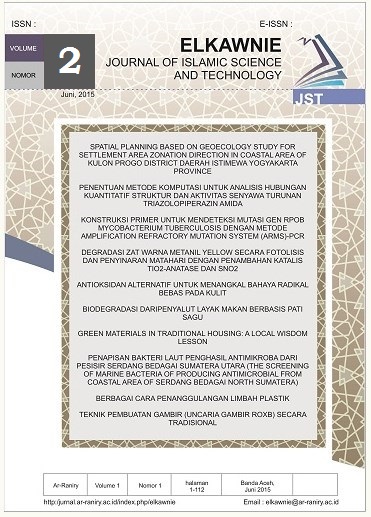Low Chlorine Residual and Intermittent Flow Lead to Coliforms Presence: A Study Case on Banda Aceh Water Supply System
DOI:
https://doi.org/10.22373/ekw.v2i1.684Keywords:
Intermittent Flow, Coliforms, Chlorine Residual, ChlorinationAbstract
Even though the water is supplied from Water Treatment Plant 24 hours a day, some consumers of Tirta Daroy Water Supply Company receive water in their taps intermittently. This condition leads to several reported pipe breaks and coliforms presence, as well. Tirta Daroy conducts a quality control activity so called Pamkor on regular basis. This study is conducted to analyse data obtained from this activity during 2014, with the focus on the total coliforms for total 161 sampling connections. The result demonstrates that the coliforms presence is encouraged by the low chlorine residual and intermittent supply. Additional finding shows these two conditions occur mainly at the areas which have long distance to the water treatment plant.References
Charalambous, Bambos. Water Supply Networks and Pipelines: The Hidden Costs of Resorting to Intermittent Supplies. IWA Water December 21, 2011. 2011.
Cohn, Perry D.; Cox, Michael; Berger, Paul S. Health and Aesthetic Aspects of Water Quality (In: Water Quality and Treatment: A Handbook of Community Water Supplies - 5th Edition. Editor: Letterman, Raymond D. New York: McGraw-Hill. 1999).
Gray, Nick F. Water Technology: An Introduction for Environmental Scientists and Engineers – 2nd Edition. Dublin: Elsevier Science & Technology Books. 2005.
Hesby, James C. Oxidation and Disinfection (In: Water Treatment Plant Design. Editor: Edward Baruth. New York: McGraw-Hill. 2005).
Menteri Kesehatan RI. Peraturan Menteri Kesehatan Republik Indonesia Nomor Nomor 492/MENKES/PER/IV/2010 tentang Persyaratan Kualitas Air Minum (Eng: Indonesian Public Health Minister Decree Number 492/MENKES/PER/IV/2010 about the Conditions of Drinking Water). Jakarta: Kementerian Kesehatan. 2010.
Nagari. 24-hour Water Supply: Is this Goal Achievable?. Hyderabad: Water and Sanitation Programme. 2003.
Pontius, Frederick W.; Clark, Stephen W. Drinking Water Quality Standards, Regulation, and Goals (In: Water Quality and Treatment: A Handbook of Community Water Supplies - 5th Edition. Editor: Letterman, Raymond D. New York: McGraw-Hill. 2005).
Ratnayaka, Don D.; Brandt, Malcom J.;Johnson, Michael. Twort’s Water Supply – 6th Edition. Oxford: Elsevier. 2009.
SDC and PT NWC. Lambaro WTP Operation Manual. Banda Aceh. 2007.
United Nations Environment Programme. Water Quality for Ecosystem and Human Health. Ontario: United Nations Environment Programme Global Environment Monitoring System (GEMS). 2006.
World Health Organization. Guidelines for Drinking Water Quality – 4th Edition. Malta: Gutenberg. 2011.
World Health Organization. Water Treatment and Pathogen Control: Process Efficiency in Achieving Safe Drinking Water. Edited by Mark W LeChevallier and Kwok-Keung Au. London: IWA Publishing. 2004.
Vacs Renwick, Deborah D. The Effects of an Intermittent Piped Water Network and Storage Practices on Household Water Quality in Tamale, Ghana. Massachusetts: Massachusetts Institute of Technology. Master Thesis. 2013.
Downloads
Published
Issue
Section
License
Proposed Policy for Journals That Offer Open Access Authors who publish with the Elkawnie journal agree to the following terms:
a. Authors retain copyright and grant the journal right of first publication with the work simultaneously licensed under a Creative Commons Attribution License that allows others to share the work with an acknowledgement of the work's authorship and initial publication in this journal.
b. Authors are able to enter into separate, additional contractual arrangements for the non-exclusive distribution of the journal's published version of the work (e.g., post it to an institutional repository or publish it in a book), with an acknowledgement of its initial publication in this journal.
c. Authors are permitted and encouraged to post their work online (e.g., in institutional repositories or on their website) prior to and during the submission process, as it can lead to productive exchanges, as well as earlier and greater citation of published work (see The Effect of Open Access).

























